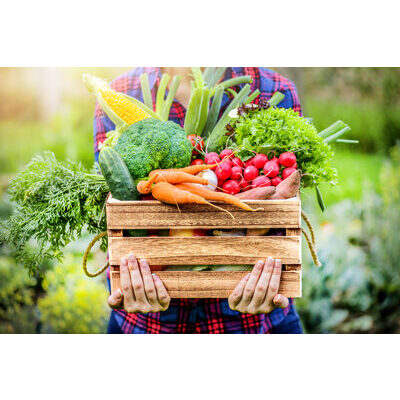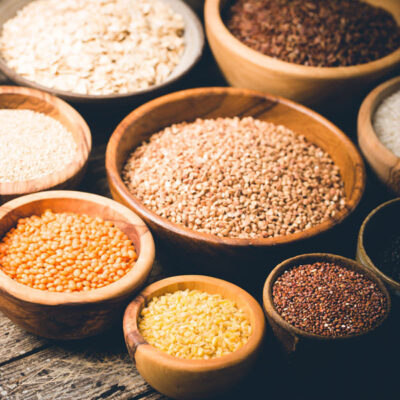Organic Fruit and Vegetables - Understanding Pesticides in our Produce
Author: admin Date Posted:11 September 2022

From Organic Fresh Foods to Organic Groceries. Most of us are aware that organic fruit and vegetables have far lower levels of pesticide residues than conventionally farmed food. But what does this really mean?
Organic fruit and vegetables are at the top of the organic shopping list, yet we are often confused about which produce to buy. Embracing an organic lifestyle is often something that we do gradually, based on our budget and our own personal priorities. So, what should we consider when choosing organic produce?
People buy organic food for a number of reasons based on concern over the effects of conventional farming on the environment, human health, and animal welfare. A key issue is the use of pesticides in farming.
Most of us are aware that organic fruit and vegetables have far lower levels of pesticide residues than conventionally farmed food. But what does this really mean? We dig deeper in order to understand more about pesticide use in farming and its impact on our food supply, as well as the legislation that governs it.
Use of chemicals in agriculture.
Once upon a time all farming was organic. Yet, by the 1940s and the end of World War II, the chemist was king. By the 1950s the industrialisation of agriculture was well under way, fuelled by the increased use of pesticides on our crops.
The first generation of pesticides were highly toxic substances based on heavy metals such as lead and mercury. The second generation of pesticides were synthetic organic compounds. These may sound benign but they included DDT, a now mostly banned chemical that caused widespread damage to human health and the environment.
The most recent generation of pesticides to emerge are derived from plants (again, not quite as benign as they sound). These include pyrethroids, rotenoids, and nicotinoids.
With each new generation of pesticides, the goal is to develop substances that are degradable or quickly deactivated, and we continually strive towards safer, greener alternatives.
Why use pesticides?
As the name suggests, pesticides help protect plants from pests and disease. They are used by farmers to control the pests and disease that damage and destroy food crops. There are many different types of pesticides, each doing a different job in a different way. Herbicides control weeds, insecticides control insects, and fungicides control fungal diseases; yet these are to name but a few. They are also used in a multitude of different ways. Most commonly they are sprayed over crops.
The United Nations estimates that up to 40% of crops are lost each year because of weeds, pests, or disease. The use of pesticides helps to mitigate this loss and help to keep food costs down.
The downsides of pesticides
Pesticide use raises a number of concerns for both human health and the environment. Potentially toxic to humans and other species, these substances have (directly and indirectly) contributed to the decline of our natural biodiversity; the very thing that keeps our entire ecosystem in balance.
Carried by wind, and leached into water, pesticides often reach destinations far beyond their target. One way or another they enter the food chain and there they remain. Persistent chemicals accumulate in the environment, and in the body, and from there they can build up to harmful levels.
Regulation of our food supply.
Each country has its own agricultural policies based on their unique geography and climate. They regulate the use of agricultural chemicals and monitor residual levels of pesticides in produce and establish legal safe limits. Use of pesticides is determined by risk assessment, and governed by health and safety laws. Measures such as 'pre-harvest intervals' require that crops may not be harvested before a certain period after pesticide application.
There is a global standard for monitoring pesticide levels in produce which is defined by the food and agricultural organisation of the United Nations, and the World Health Organisations. Known as the codex-alimentarius it defines acceptable residue limits, but is a set of guidelines not legislation. Countries, and even regions, define their own 'maximum residue limits' and 'acceptable daily intake'.
Tolerance levels are determined based upon factors such as: the toxicity of the pesticide, the amount and frequency of application, and how much residue remains. The effects are only tested on single pesticides and do not allow for the synergistic effect of multiple substances and their accumulation.
The challenge is to achieve a balance between a reliable food supply and protection against chemical exposure. In a landscape (both literal and metaphorical) that is constantly shifting.
Monitoring pesticide residues.
Type a query into Google about which organic food to buy and (wherever in the world you may be) you will undoubtedly come up with references to the dirty dozen and the clean fifteen.
It comes from the EWG Shoppers Guide to Pesticides in Produce Report, which in turn pulls its data from studies done by the United States Department of Agriculture and the (US) Food and Drug Administration. The study itself is possibly the largest, most up-to-date of its kind. It is certainly the most accessible to those without a research/science based degree. And, although it does differentiate between domestic and imported produce, it is of most relevance to shoppers in the United States.
The EWG Shopper's Guide
The shopper's guide ranks 46 types of fruit and vegetables according to their levels of pesticide contamination, using samples taken by the USDA and the FDA. It is published each year, using the most recent sampling of each food. Interestingly, when the samples are tested, they are first prepared as they would be in the domestic home. That is they are washed/scrubbed, and skins are removed where appropriate.
Several measures of contamination for each food/crop are considered:
- percentage of samples tested that have detectable pesticide residues
- percentage of samples tested that have two or more detectable residues
- average number of pesticides in a single sample
- average amount of pesticides in parts per million (ppm)
- maximum number of pesticides found in a single sample
- total number of pesticides found on the crop
They also differentiate between domestic crops and imported crops.
The EWG shopper's guide takes these findings and ranks them on a scale of 1 - 100, with 100 being the highest. All pesticides are weighted equally, with the aim of enabling consumers to reduce their overall pesticide load.
At the time of writing, in 2022, the list is:
The Dirty Dozen
- strawberries
- spinach
- kale
- nectarines
- apples
- grapes
- hot peppers and bell peppers
- cherries
- peaches
- pears
- celery
- tomatoes
The Clean 15
- avocado
- corn
- pineapple
- onions
- papaya
- peas
- asparagus
- honeydew melon
- kiwi
- cabbage
- mushrooms
- cantaloupe
- mango
- watermelon
- sweet potatoes
The In-between
- potatoes
- blueberries
- cherry tomatoes
- winter squash
- lettuce
- cucumbers
- tangerines
- green beans
- plums
- broccoli
- aubergine
- raspberries
- summer squash
- grapefruit
- snap peas
- oranges
- carrots
- bananas
- cauliflower
But is it really that simple?
In an ideal world we would all be eating organic fruit and vegetables, free from potential toxic pesticides and chemicals. That much is obvious. But what lies behind those numbers? Can we base our food decisions based purely on the data and legislation of one country?
Whilst it may be true that some crops are naturally more vulnerable to disease than others, and that a strawberry is a strawberry the world over, there will be major differences in how those crops are grown. Any gardener will tell you that location is everything. What withers and dies in one corner of the garden, will thrive in another. Now imagine that concept on a global scale.
Let's use an example to illustrate this point further.
Australia has a reputation for producing clean food, yet there has been recent criticism about our country's 'incautious use of pesticides'. In a backlash over international trade agreements with the UK, Australia has come under fire for the use of neonicotinoid substances currently banned in Europe for their negative impact on European honeybee populations.
Yet, in Australia, native honeybee populations are not in decline. The risk assessment that led to the use of these particular substances, on these particular crops, in this particular location, was based on criteria relevant to the environment in which it was produced.
What this serves to underline is not the use of chemicals that endanger wildlife, but the issues of a global food system. The risks and benefits of a particular pesticide will differ greatly between countries, and even regions, resulting in very different regulations. The move for local produce goes far beyond air miles and internal politics. As more and more food is shifted around the globe, it raises complex issues of measurement, legislation, and traceability.
What about organic fruit and vegetables?
The use of pesticides was a prime factor for the beginning of the organic food movement, which has been around since the industrialisation of agriculture over 80 years ago. Chemical analysis consistently shows that organic fruit and vegetables have significantly lower pesticide residue levels.
The improved safety of the organic food system is centered around the damage to environmental and human health through the use of pesticides, as well as other industrial farming methods. Organic food is produced by the standards of organic farming, which includes the regulation of certain pesticides and fertilisers. Instead, organic farming relies on traditional farming practices such as crop rotation and manual weeding to control pest and diseases.
Large scale organic and minimal intervention
It can be helpful to view organic farming on a spectrum. In the middle is the classic view of an organic farm, striving to uphold the standards and ideals of everything that the organic food system entails. At one end sits large scale organic farming which manages to produce food (maybe just) within the organic standard, yet still functions on a somewhat industrial scale. At the other end sits the minimal intervention, or even just regular farmer. These producers may not have organic certification yet they embrace the principles of organic farming.
Responsible farmers only use pesticides and agricultural chemicals when they need to, as part of a wider approach focused upon traditional farming practices and a respect for the land. They are most often mid to small scale producers that are either working towards organic certification or simply do not believe that they need a label in order to produce good, safe food.
A final word
The world has learned some harsh lessons about the failings of our food systems, and we have come a long way in trying to undo some of the damage we have done to our ecosystem, and our health. Yet an ever expanding population means that we are constantly trying to find new ways to produce more food from the same amount of land, and with less impact upon the environment.
Choosing organic fruit and vegetables remains the best way to reduce our toxic load, on both the environment and the health of ourselves and those we love. Yet this is just one piece of a bigger puzzle and we hope that this article goes a little way towards explaining the complexities we face.
Here at Opera Foods we believe wholeheartedly in supporting an organic lifestyle and a healthy balanced diet of natural whole foods. Where possible the products we produce and supply are organic, yet we also support those small scale farmers and producers that are doing their best to embrace organic farming principles and lessen their environmental load. Why not check out our growing range of organic groceries?
If you found this article interesting please share it with your friends. You can also find out more about organic food with our article on choosing organic groceries.



